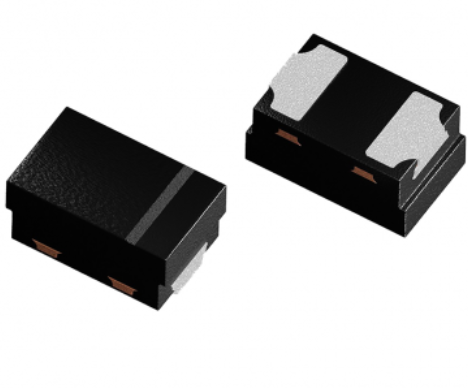Vishay Intertechnology releases a new Automotive Grade bidirectional single-line ESD protection diode in the compact DFN1006-2B package with wettable flanks.
Optimised for automotive Ethernet networks in compliance with OPEN Alliance 100Base-T1 and 1000Base-T1 specifications, the space-saving VETH100A1DD1 offers low clamping voltage, dynamic resistance, and capacitance for the protection of high speed data lines against transient voltage signals.
Offering a smaller footprint and lower profile than other standard packages, the device features a very low clamping voltage of 31V typical at 1A, a result of its snap-back technology with a trigger voltage > 100V. Combined with low dynamic resistance of 0.4W typical, the protection diode delivers improved ESD absorption performance and protection, while its low maximum capacitance of 2pF enables higher signal integrity.
The VETH100A1DD1 provides transient protection for data lines as per ISO 10605 and IEC 61000 4 2at ± 15kV (contact discharge) for 1,000 pulses. For automotive applications, the protection diode is available in an AEC-Q101 version and offers a working voltage of ± 24V. End products for the device include industrial automation systems, computers, consumer entertainment devices, home appliances, fixed telecom infrastructure, and medical instrumentation.
The protection diode offers a moisture sensitivity level (MSL) of one in accordance with J-STD-020 and a UL 94 V-0 flammability rating. RoHS-compliant, halogen-free, and Vishay Green, the device supports automated optical inspection (AOI) for automotive systems.
Samples and production quantities of the VETH100A1DD1 are available now, with lead times of 20 weeks.
Original article source:
FAQ
- What is the purpose of ESD diodes in automotive Ethernet?
– ESD (Electrostatic Discharge) diodes are used to protect automotive Ethernet interfaces from electrostatic discharges and transient voltage spikes that can cause damage to sensitive components.
- What are the key features of Vishay’s ESD diodes for automotive Ethernet?
– Compact packages for space-saving designs.
– Low capacitance for high-speed data transmission.
– High surge handling capability.
– Compliance with AEC-Q101 standards for automotive-grade reliability.
– Low clamping voltage for better protection.
- Which compact packages are available for these ESD diodes?
– Vishay offers these ESD diodes in compact packages such as SOT-23, SOD-323, SOD-523, and DFN (dual-flat no-leads) packages, which are suitable for automotive Ethernet applications.
- What are the typical applications of these ESD diodes in the automotive sector?
– They are used in automotive Ethernet applications, including Advanced Driver Assistance Systems (ADAS), infotainment systems, and in-vehicle networking.
- How do Vishay ESD diodes ensure minimal signal distortion in high-speed automotive Ethernet?
– These diodes have ultra-low capacitance, which helps to minimize signal distortion, ensuring high-speed data integrity in automotive Ethernet networks.
- What are the voltage ratings available for these ESD diodes?
– Vishay ESD diodes typically offer working voltage ratings around 3.3V, 5V, and up to 24V to cover different automotive Ethernet and data line protection needs.
- Are these ESD diodes RoHS compliant?
– Yes, Vishay’s ESD diodes for automotive Ethernet are RoHS compliant, meeting environmental and safety standards.
